Abstract
Rats and other rodents are exposed by inhalation to identify agents that might present hazards for lung cancer in humans exposed by inhalation. In some cases, the results are used in attempts to develop quantitative estimates of human lung cancer risk. This report reviews evidence for the usefulness of the rat for evaluation of lung cancer hazards from inhaled particles. With the exception of nickel sulfate, particulate agents thought to be human lung carcinogens cause lung tumors in rats exposed by inhalation. The rat is more sensitive to carcinogenesis from nonfibrous particles than mice or Syrian hamsters, which have both produced false negatives. However, rats differ from mice and nonhuman primates in both the pattern of particle retention in the lung and alveolar epithelial hyperplastic responses to chronic particle exposure. Present evidence warrants caution in extrapolation from the lung tumor response of rats to inhaled particles to human lung cancer hazard, and there is considerable uncertainty in estimating unit risks for humans from rat data. It seems appropriate to continue using rats in inhalation carcinogenesis assays of inhaled particles, but the upper limit of exposure concentrations must be set carefully to avoid false-positive results. A positive finding in both rats and mice would give greater confidence that an agent presents a carcinogenic hazard to man, and both rats and mice should be used if the agent is a gas or vapor. There is little justification for including Syrian hamsters in assays of the intrapulmonary carcinogenicity of inhaled agents.
Full text
PDF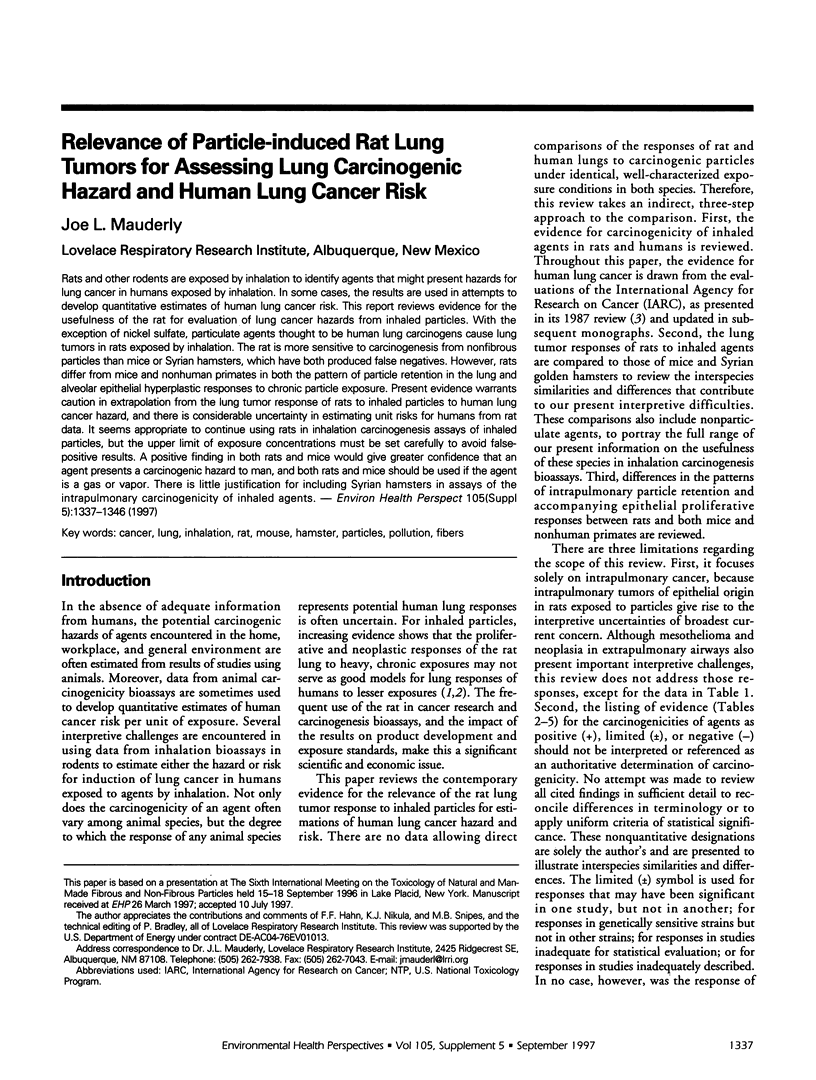

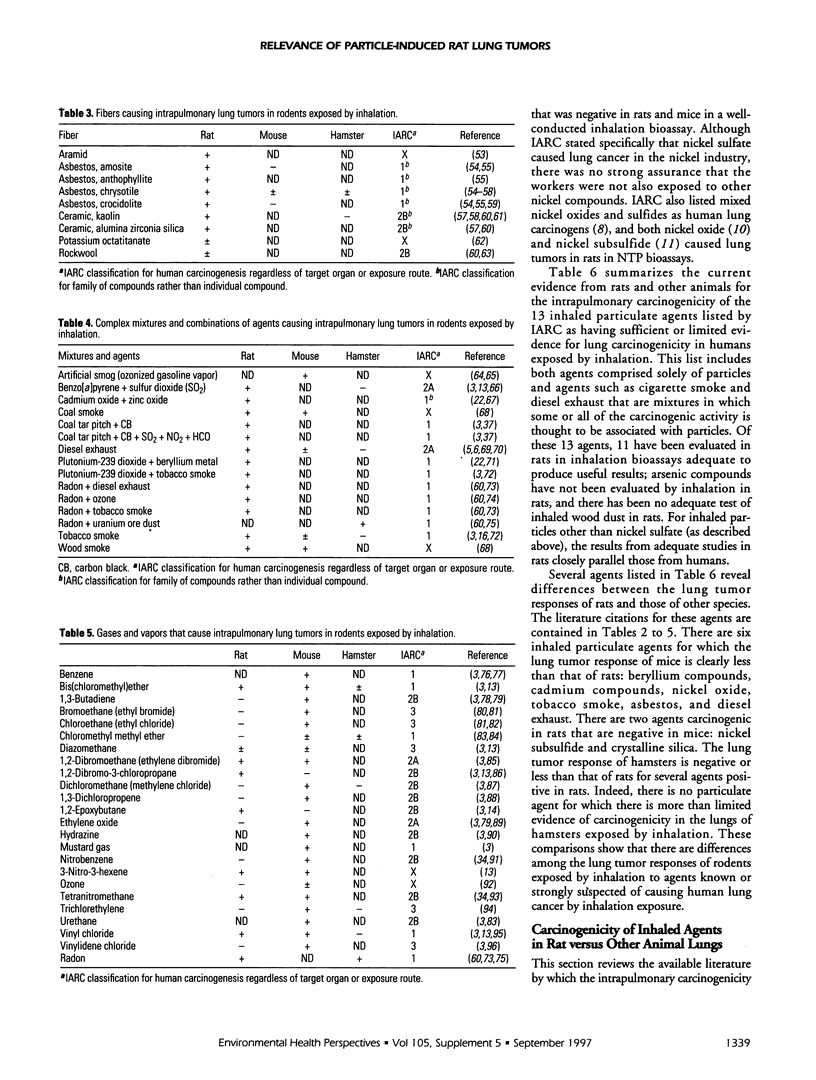

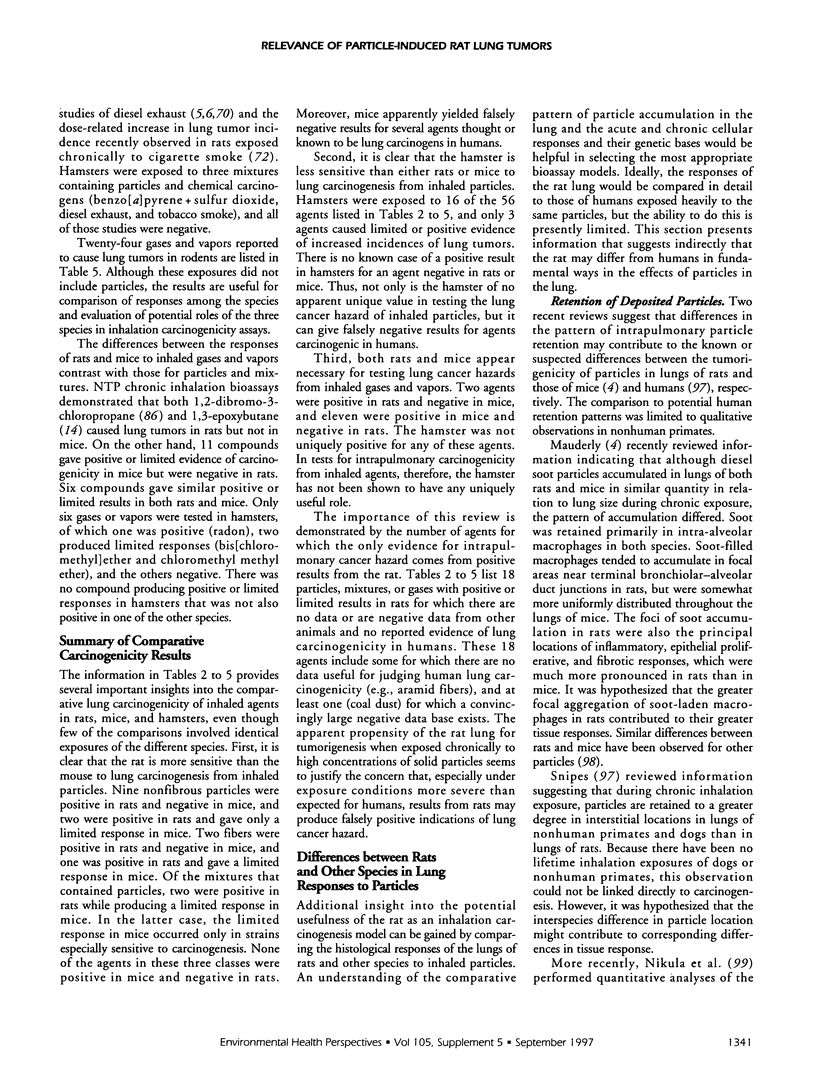
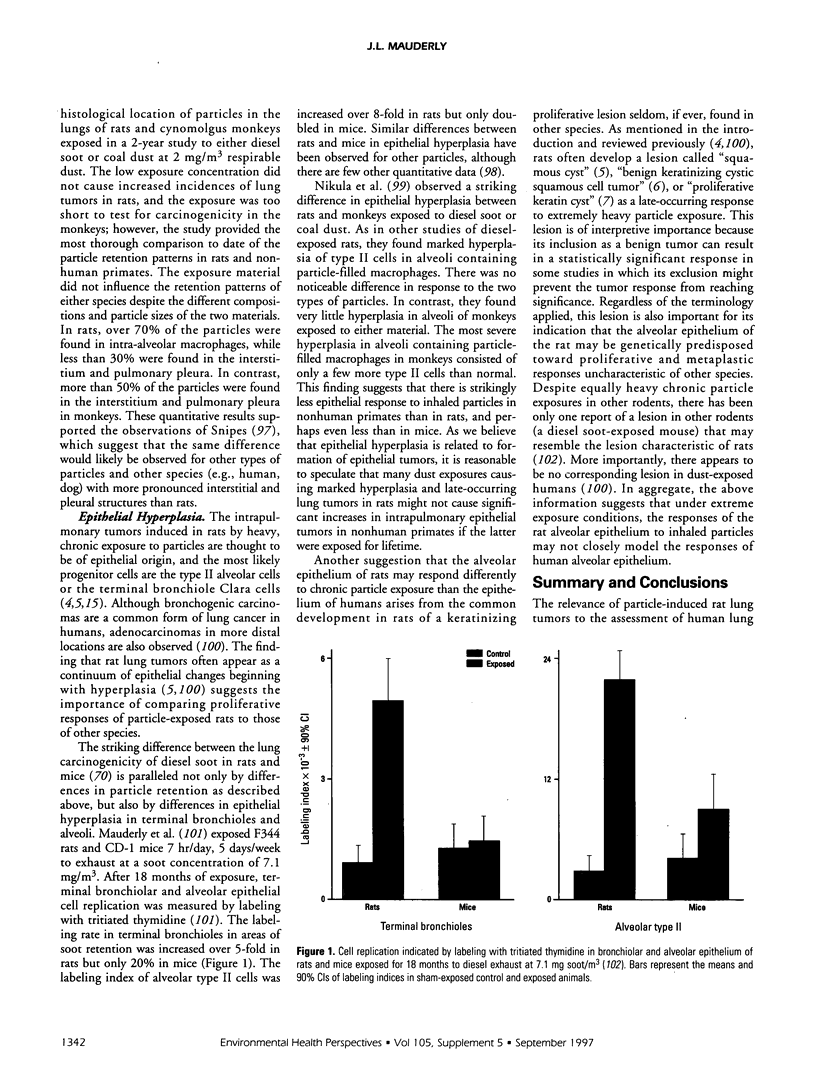

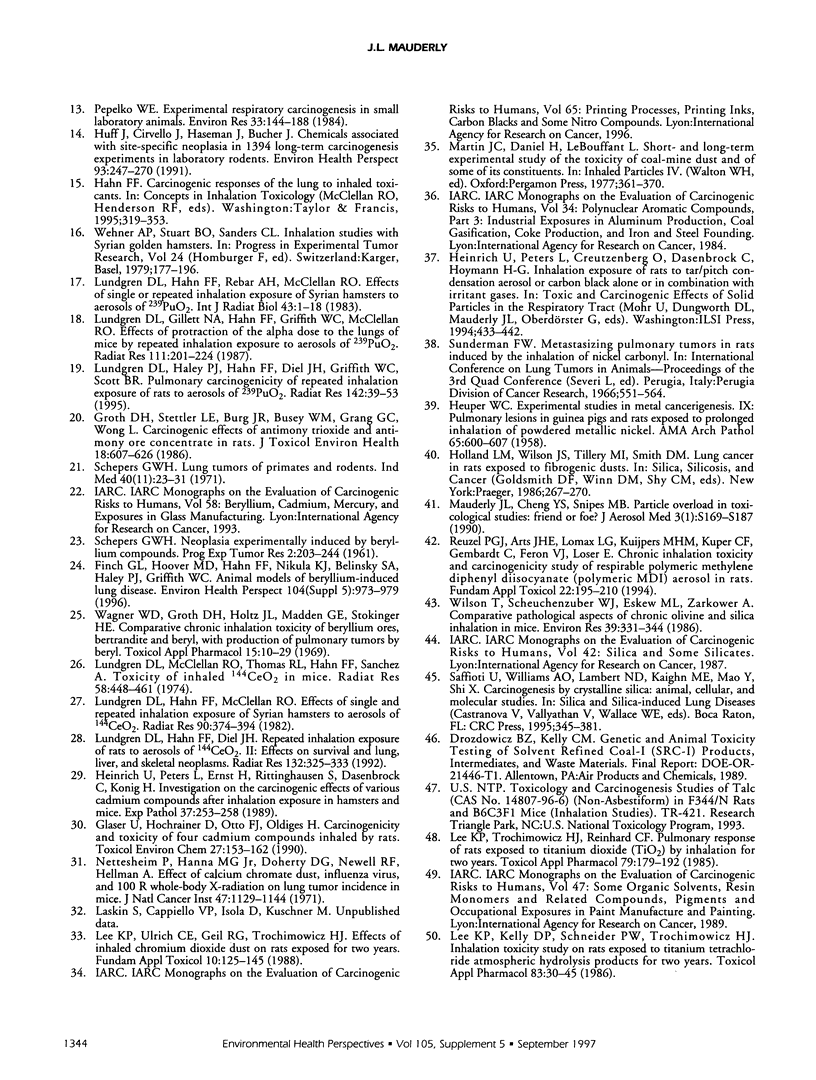
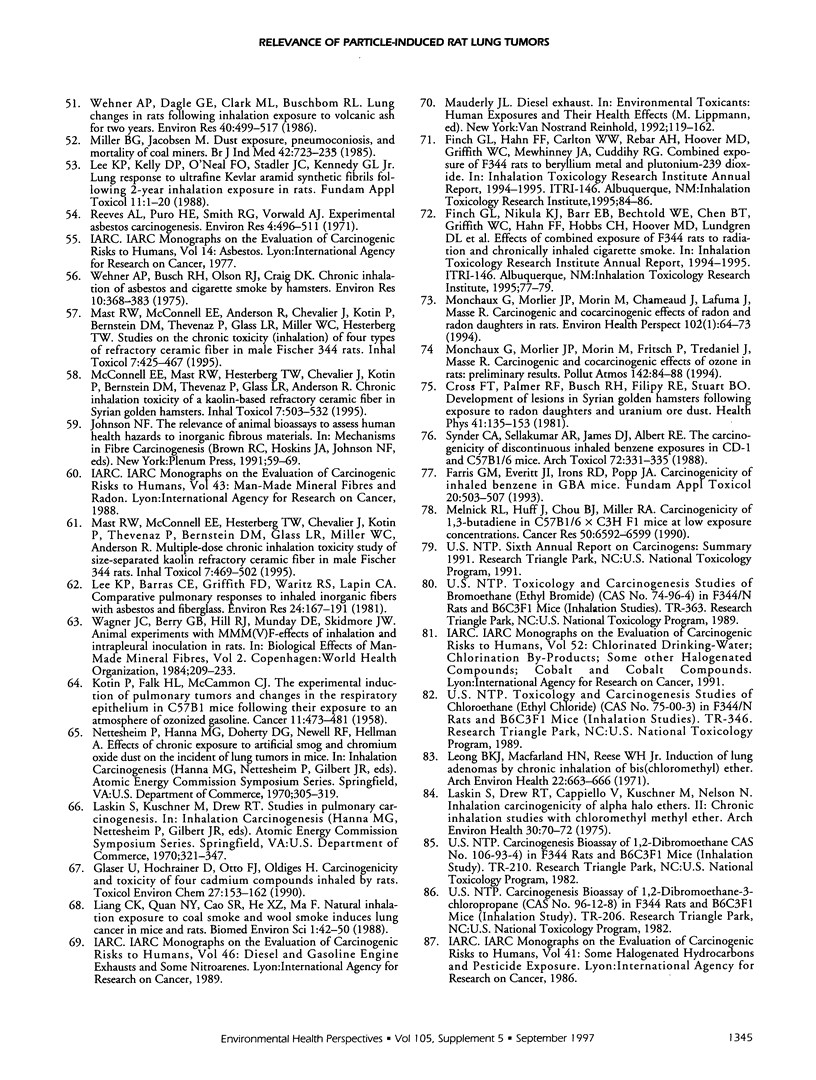
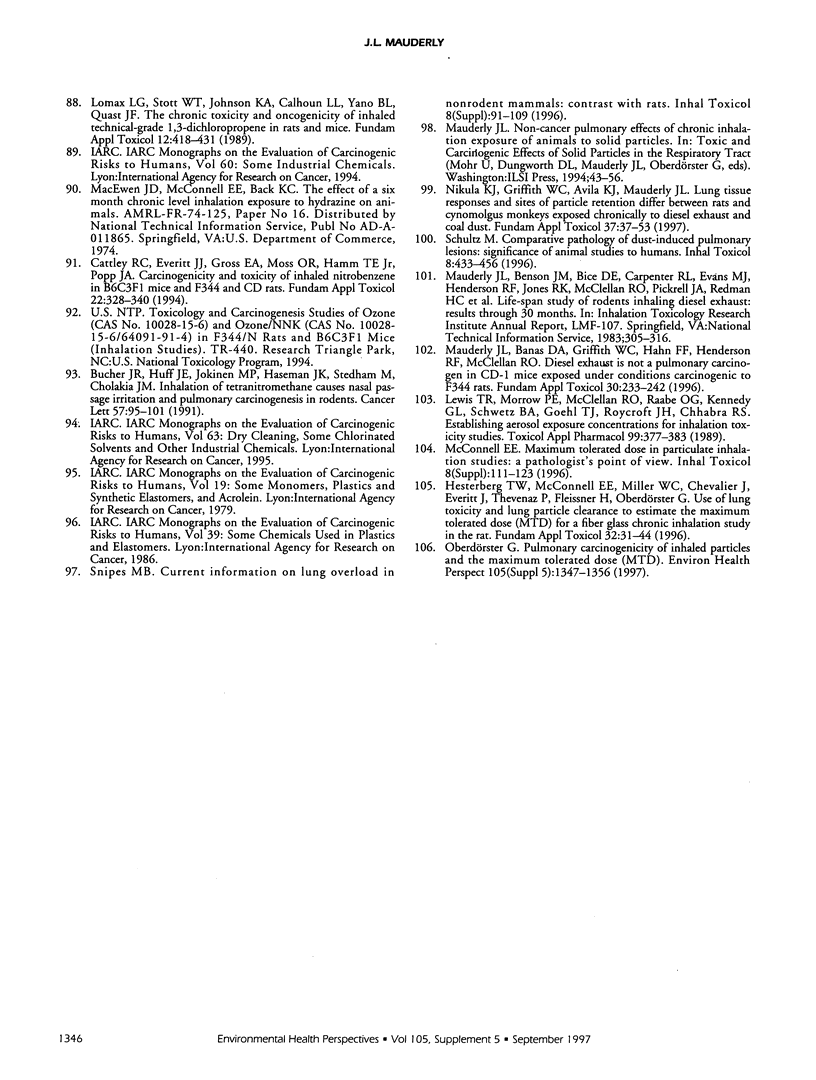
Selected References
These references are in PubMed. This may not be the complete list of references from this article.
- Bucher J. R., Huff J. E., Jokinen M. P., Haseman J. K., Stedham M., Cholakis J. M. Inhalation of tetranitromethane causes nasal passage irritation and pulmonary carcinogenesis in rodents. Cancer Lett. 1991 May 1;57(2):95–101. doi: 10.1016/0304-3835(91)90201-r. [DOI] [PubMed] [Google Scholar]
- Cattley R. C., Everitt J. I., Gross E. A., Moss O. R., Hamm T. E., Jr, Popp J. A. Carcinogenicity and toxicity of inhaled nitrobenzene in B6C3F1 mice and F344 and CD rats. Fundam Appl Toxicol. 1994 Apr;22(3):328–340. doi: 10.1006/faat.1994.1039. [DOI] [PubMed] [Google Scholar]
- Cross F. T., Palmer R. F., Busch R. H., Filipy R. E., Stuart B. O. Development of lesions in Syrian golden hamsters following exposure to radon daughters and uranium ore dust. Health Phys. 1981 Jul;41(1):135–153. doi: 10.1097/00004032-198107000-00012. [DOI] [PubMed] [Google Scholar]
- Farris G. M., Everitt J. I., Irons R. D., Popp J. A. Carcinogenicity of inhaled benzene in CBA mice. Fundam Appl Toxicol. 1993 May;20(4):503–507. doi: 10.1006/faat.1993.1061. [DOI] [PubMed] [Google Scholar]
- Finch G. L., Hoover M. D., Hahn F. F., Nikula K. J., Belinsky S. A., Haley P. J., Griffith W. C. Animal models of beryllium-induced lung disease. Environ Health Perspect. 1996 Oct;104 (Suppl 5):973–979. doi: 10.1289/ehp.96104s5973. [DOI] [PMC free article] [PubMed] [Google Scholar]
- Groth D. H., Stettler L. E., Burg J. R., Busey W. M., Grant G. C., Wong L. Carcinogenic effects of antimony trioxide and antimony ore concentrate in rats. J Toxicol Environ Health. 1986;18(4):607–626. doi: 10.1080/15287398609530898. [DOI] [PubMed] [Google Scholar]
- HUEPER W. C. Experimental studies in metal cancerigenesis. IX. Pulmonary lesions in guinea pigs and rats exposed to prolonged inhalation of powdered metallic nickel. AMA Arch Pathol. 1958 Jun;65(6):600–607. [PubMed] [Google Scholar]
- Heinrich U., Peters L., Ernst H., Rittinghausen S., Dasenbrock C., König H. Investigation on the carcinogenic effects of various cadmium compounds after inhalation exposure in hamsters and mice. Exp Pathol. 1989;37(1-4):253–258. doi: 10.1016/s0232-1513(89)80063-5. [DOI] [PubMed] [Google Scholar]
- Hesterberg T. W., McConnel E. E., Miiller W. C., Chevalier J., Everitt J., Thevenaz P., Fleissner H., Oberdörster G. Use of lung toxicity and lung particle clearance to estimate the maximum tolerated dose (MTD) for a fiber glass chronic inhalation study in the rat. Fundam Appl Toxicol. 1996 Jul;32(1):31–44. doi: 10.1006/faat.1996.0104. [DOI] [PubMed] [Google Scholar]
- Huff J., Cirvello J., Haseman J., Bucher J. Chemicals associated with site-specific neoplasia in 1394 long-term carcinogenesis experiments in laboratory rodents. Environ Health Perspect. 1991 Jun;93:247–270. doi: 10.1289/ehp.9193247. [DOI] [PMC free article] [PubMed] [Google Scholar]
- KOTIN P., FALK H. L., McCAMMON C. J., 3rd The experimental induction of pulmonary tumors and changes in the respiratory epithelium in C57BL mice following their exposure to an atmosphere of ozonized gasoline. Cancer. 1958 May-Jun;11(3):473–481. doi: 10.1002/1097-0142(195805/06)11:3<473::aid-cncr2820110307>3.0.co;2-w. [DOI] [PubMed] [Google Scholar]
- Laskin S., Drew R. T., Capiello V., Kuschner M., Nelson N. Inhalation carcinogenicity of alpha halo ethers. II. Chronic inhalation studies with chloromethyl methyl ether. Arch Environ Health. 1975 Feb;30(2):70–72. doi: 10.1080/00039896.1975.10666645. [DOI] [PubMed] [Google Scholar]
- Lee K. P., Barras C. E., Griffith F. D., Waritz R. S., Lapin C. A. Comparative pulmonary responses to inhaled inorganic fibers with asbestos and fiberglass. Environ Res. 1981 Feb;24(1):167–191. doi: 10.1016/0013-9351(81)90143-2. [DOI] [PubMed] [Google Scholar]
- Lee K. P., Kelly D. P., O'Neal F. O., Stadler J. C., Kennedy G. L., Jr Lung response to ultrafine Kevlar aramid synthetic fibrils following 2-year inhalation exposure in rats. Fundam Appl Toxicol. 1988 Jul;11(1):1–20. doi: 10.1016/0272-0590(88)90265-5. [DOI] [PubMed] [Google Scholar]
- Lee K. P., Kelly D. P., Schneider P. W., Trochimowicz H. J. Inhalation toxicity study on rats exposed to titanium tetrachloride atmospheric hydrolysis products for two years. Toxicol Appl Pharmacol. 1986 Mar 30;83(1):30–45. doi: 10.1016/0041-008x(86)90320-0. [DOI] [PubMed] [Google Scholar]
- Lee K. P., Trochimowicz H. J., Reinhardt C. F. Pulmonary response of rats exposed to titanium dioxide (TiO2) by inhalation for two years. Toxicol Appl Pharmacol. 1985 Jun 30;79(2):179–192. doi: 10.1016/0041-008x(85)90339-4. [DOI] [PubMed] [Google Scholar]
- Lee K. P., Ulrich C. E., Geil R. G., Trochimowicz H. J. Effects of inhaled chromium dioxide dust on rats exposed for two years. Fundam Appl Toxicol. 1988 Jan;10(1):125–145. doi: 10.1016/0272-0590(88)90258-8. [DOI] [PubMed] [Google Scholar]
- Leong B. K., Macfarland H. N., Reese W. H., Jr Induction of lung adenomas by chronic inhalation of bis (chloromethyl) ether. Arch Environ Health. 1971 Jun;22(6):663–666. doi: 10.1080/00039896.1971.10665920. [DOI] [PubMed] [Google Scholar]
- Lewis T. R., Morrow P. E., McClellan R. O., Raabe O. G., Kennedy G. L., Schwetz B. A., Goehl T. J., Roycroft J. H., Chhabra R. S. Establishing aerosol exposure concentrations for inhalation toxicity studies. Toxicol Appl Pharmacol. 1989 Jul;99(3):377–383. doi: 10.1016/0041-008x(89)90147-6. [DOI] [PubMed] [Google Scholar]
- Liang C. K., Quan N. Y., Cao S. R., He X. Z., Ma F. Natural inhalation exposure to coal smoke and wood smoke induces lung cancer in mice and rats. Biomed Environ Sci. 1988 Jun;1(1):42–50. [PubMed] [Google Scholar]
- Lomax L. G., Stott W. T., Johnson K. A., Calhoun L. L., Yano B. L., Quast J. F. The chronic toxicity and oncogenicity of inhaled technical-grade 1,3-dichloropropene in rats and mice. Fundam Appl Toxicol. 1989 Apr;12(3):418–431. doi: 10.1016/0272-0590(89)90016-x. [DOI] [PubMed] [Google Scholar]
- Lundgren D. L., Gillett N. A., Hahn F. F., Griffith W. C., McClellan R. O. Effects of protraction of the alpha dose to the lungs of mice by repeated inhalation exposure to aerosols of 239PuO2. Radiat Res. 1987 Aug;111(2):201–224. [PubMed] [Google Scholar]
- Lundgren D. L., Hahn F. F., Diel J. H. Repeated inhalation exposure of rats to aerosols of 144CeO2. II. Effects on survival and lung, liver, and skeletal neoplasms. Radiat Res. 1992 Dec;132(3):325–333. [PubMed] [Google Scholar]
- Lundgren D. L., Hahn F. F., McClellan R. O. Effects of single and repeated inhalation exposure of Syrian hamsters to aerosols of 144CeO2. Radiat Res. 1982 May;90(2):374–394. [PubMed] [Google Scholar]
- Lundgren D. L., Hahn F. F., Rebar A. H., McClellan R. O. Effects of the single or repeated inhalation exposure of Syrian hamsters to aerosols of 239PuO2. Int J Radiat Biol Relat Stud Phys Chem Med. 1983 Jan;43(1):1–18. doi: 10.1080/09553008314550011. [DOI] [PubMed] [Google Scholar]
- Lundgren D. L., Haley P. J., Hahn F. F., Diel J. H., Griffith W. C., Scott B. R. Pulmonary carcinogenicity of repeated inhalation exposure of rats to aerosols of 239PuO2. Radiat Res. 1995 Apr;142(1):39–53. [PubMed] [Google Scholar]
- Lundgren D. L., McClellan R. O., Thomas R. L., Hahn F. F., Sanchez A. Toxicity of inhaled 144CeO2 in mice. Radiat Res. 1974 Jun;58(3):448–461. [PubMed] [Google Scholar]
- Mauderly J. L., Banas D. A., Griffith W. C., Hahn F. F., Henderson R. F., McClellan R. O. Diesel exhaust is not a pulmonary carcinogen in CD-1 mice exposed under conditions carcinogenic to F344 rats. Fundam Appl Toxicol. 1996 Apr;30(2):233–242. doi: 10.1006/faat.1996.0061. [DOI] [PubMed] [Google Scholar]
- Melnick R. L., Huff J., Chou B. J., Miller R. A. Carcinogenicity of 1,3-butadiene in C57BL/6 x C3H F1 mice at low exposure concentrations. Cancer Res. 1990 Oct 15;50(20):6592–6599. [PubMed] [Google Scholar]
- Miller B. G., Jacobsen M. Dust exposure, pneumoconiosis, and mortality of coalminers. Br J Ind Med. 1985 Nov;42(11):723–733. doi: 10.1136/oem.42.11.723. [DOI] [PMC free article] [PubMed] [Google Scholar]
- Monchaux G., Morlier J. P., Morin M., Chameaud J., Lafuma J., Masse R. Carcinogenic and cocarcinogenic effects of radon and radon daughters in rats. Environ Health Perspect. 1994 Jan;102(1):64–73. doi: 10.1289/ehp.9410264. [DOI] [PMC free article] [PubMed] [Google Scholar]
- Nettesheim P., Hanna M. G., Jr, Doherty D. G., Newell R. F., Hellman A. Effect of calcium chromate dust, influenza virus, and 100 R whole-body x radiation on lung tumor incidence in mice. J Natl Cancer Inst. 1971 Nov;47(5):1129–1144. [PubMed] [Google Scholar]
- Nikula K. J., Avila K. J., Griffith W. C., Mauderly J. L. Lung tissue responses and sites of particle retention differ between rats and cynomolgus monkeys exposed chronically to diesel exhaust and coal dust. Fundam Appl Toxicol. 1997 May;37(1):37–53. doi: 10.1006/faat.1997.2297. [DOI] [PubMed] [Google Scholar]
- Nikula K. J., Snipes M. B., Barr E. B., Griffith W. C., Henderson R. F., Mauderly J. L. Comparative pulmonary toxicities and carcinogenicities of chronically inhaled diesel exhaust and carbon black in F344 rats. Fundam Appl Toxicol. 1995 Apr;25(1):80–94. doi: 10.1093/toxsci/25.1.80. [DOI] [PMC free article] [PubMed] [Google Scholar]
- Oberdörster G. Pulmonary carcinogenicity of inhaled particles and the maximum tolerated dose. Environ Health Perspect. 1997 Sep;105 (Suppl 5):1347–1355. doi: 10.1289/ehp.105-1470142. [DOI] [PMC free article] [PubMed] [Google Scholar]
- Pepelko W. E. Experimental respiratory carcinogenesis in small laboratory animals. Environ Res. 1984 Feb;33(1):144–188. doi: 10.1016/0013-9351(84)90015-x. [DOI] [PubMed] [Google Scholar]
- Reuzel P. G., Arts J. H., Lomax L. G., Kuijpers M. H., Kuper C. F., Gembardt C., Feron V. J., Löser E. Chronic inhalation toxicity and carcinogenicity study of respirable polymeric methylene diphenyl diisocyanate (polymeric MDI) aerosol in rats. Fundam Appl Toxicol. 1994 Feb;22(2):195–210. doi: 10.1006/faat.1994.1024. [DOI] [PubMed] [Google Scholar]
- SCHEPERS G. W. Neoplasia experimentally induced by beryllium compounds. Prog Exp Tumor Res. 1961;2:203–244. doi: 10.1159/000385954. [DOI] [PubMed] [Google Scholar]
- Schepers G. W. Lung tumors of primates and rodents. II. IMS Ind Med Surg. 1971 May;40(2):23–31. [PubMed] [Google Scholar]
- Snyder C. A., Sellakumar A. R., James D. J., Albert R. E. The carcinogenicity of discontinuous inhaled benzene exposures in CD-1 and C57Bl/6 mice. Arch Toxicol. 1988;62(5):331–335. doi: 10.1007/BF00293618. [DOI] [PubMed] [Google Scholar]
- Wagner W. D., Groth D. H., Holtz J. L., Madden G. E., Stokinger H. E. Comparative chronic inhalation toxicity of beryllium ores, bertrandite and beryl, with production of pulmonary tumors by beryl. Toxicol Appl Pharmacol. 1969 Jul;15:10–29. doi: 10.1016/0041-008x(69)90127-6. [DOI] [PubMed] [Google Scholar]
- Wehner A. P., Busch R. H., Olson R. J., Craig D. K. Chronic inhalation of asbestos and cigarette smoke by hamsters. Environ Res. 1975 Dec;10(3):368–383. doi: 10.1016/0013-9351(75)90032-8. [DOI] [PubMed] [Google Scholar]
- Wehner A. P., Dagle G. E., Clark M. L., Buschbom R. L. Lung changes in rats following inhalation exposure to volcanic ash for two years. Environ Res. 1986 Aug;40(2):499–517. doi: 10.1016/s0013-9351(86)80125-6. [DOI] [PubMed] [Google Scholar]
- Wehner A. P., Stuart B. O., Sanders C. L. Inhalation studies with Syrian golden hamsters. Prog Exp Tumor Res. 1979;24:177–198. doi: 10.1159/000402095. [DOI] [PubMed] [Google Scholar]
- Wilson T., Scheuchenzuber W. J., Eskew M. L., Zarkower A. Comparative pathological aspects of chronic olivine and silica inhalation in mice. Environ Res. 1986 Apr;39(2):331–344. doi: 10.1016/s0013-9351(86)80059-7. [DOI] [PubMed] [Google Scholar]


